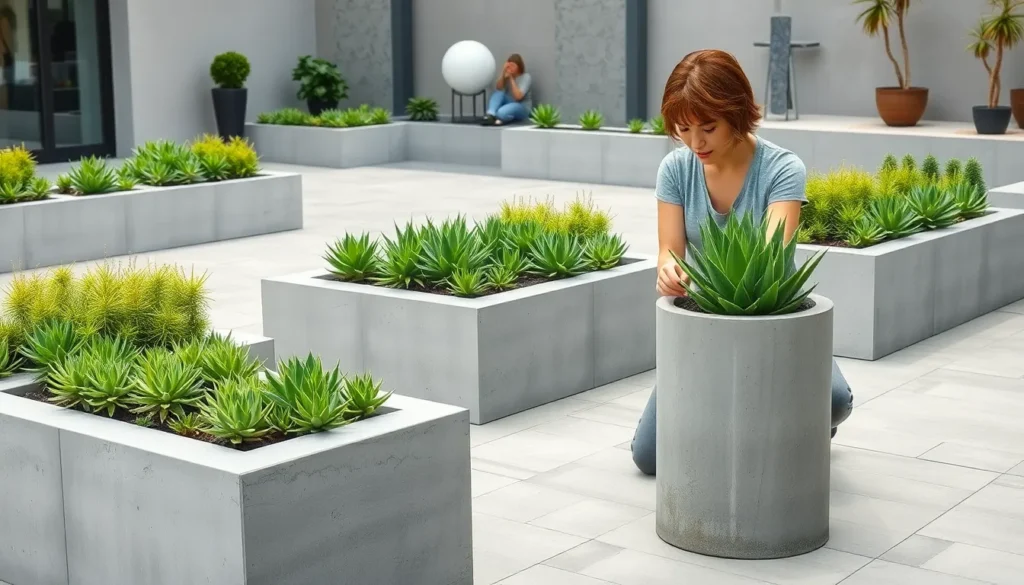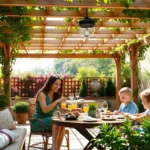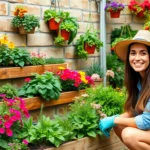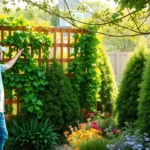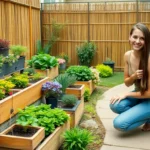Concrete gardens are revolutionizing outdoor spaces with their perfect blend of durability and style. We’ve discovered that modern homeowners are embracing this versatile material to create stunning landscapes that require minimal maintenance while delivering maximum visual impact.
Gone are the days when concrete meant boring gray slabs. Today’s concrete garden designs showcase incredible creativity through stamped patterns, vibrant colors, and innovative textures that mimic natural stone, wood, and brick. We’re seeing everything from sleek minimalist patios to intricate decorative pathways that transform ordinary yards into architectural masterpieces.
Whether you’re working with a small urban balcony or a sprawling backyard, concrete offers endless possibilities for creating functional outdoor living spaces. We’ll explore budget-friendly DIY projects alongside professional-grade installations that’ll inspire your next garden transformation. From elegant planters to striking water features, these concrete garden ideas will help you design an outdoor oasis that stands the test of time.
Modern Minimalist Concrete Planters for Urban Gardens
Sleek concrete planters transform small city spaces into sophisticated green retreats that maximize both style and functionality.
Geometric Rectangular Planter Boxes
Rectangular concrete planters create clean lines that perfectly complement contemporary urban architecture. We recommend choosing boxes measuring 24 to 36 inches in length for optimal plant arrangement flexibility. These structured vessels work exceptionally well for growing herbs, succulents, and ornamental grasses that thrive in contained environments.
Square variations measuring 18×18 inches provide excellent focal points for single statement plants like bird of paradise or large agave specimens. The geometric edges frame your plantings while creating visual boundaries that define outdoor seating areas. Modern homeowners often group these planters in odd numbers to establish ever-changing arrangements that draw the eye naturally through the space.
Cylindrical Concrete Vessels for Statement Plants
Cylindrical planters offer organic curves that soften harsh urban environments while maintaining the industrial appeal of concrete construction. We’ve found that vessels ranging from 20 to 30 inches in diameter work best for showcasing dramatic plants like Japanese maples or architectural succulents.
These round containers excel at creating natural gathering points on patios and rooftops where space feels limited. Tall cylindrical planters measuring 24 to 36 inches in height add vertical dimension without overwhelming narrow balconies or courtyard gardens. The curved surfaces catch light beautifully throughout the day while providing substantial root space for larger specimens.
Tiered Concrete Planters for Vertical Interest
Tiered systems maximize planting area in compact urban settings by utilizing vertical space efficiently. We design these multi level arrangements using planters of graduated sizes, typically starting with 36 inch bases and stepping down to 18 inch tops. This configuration allows for diverse plant combinations that create natural cascading effects.
Stepped concrete planters work particularly well for herb gardens where frequent harvesting requires easy access to different levels. The structured tiers provide excellent drainage opportunities while creating microclimates that accommodate plants with varying water and sun requirements. Urban gardeners appreciate how these systems transform blank walls into living features that enhance property values.
DIY Concrete Stepping Stones and Walkway Ideas
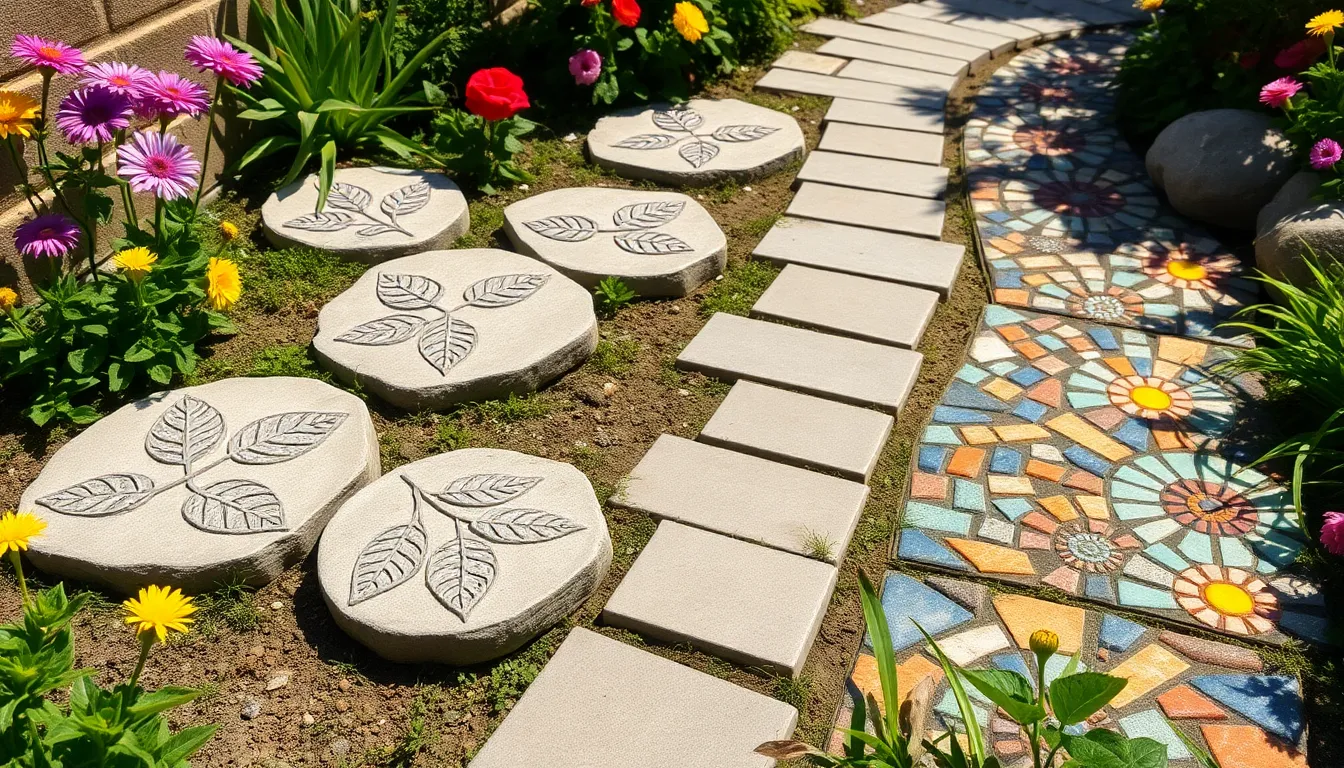
Building on our modern planter foundation, we’ll explore DIY concrete stepping stones and walkways that create stunning pathways throughout your garden space. These projects offer cost-effective alternatives to professional installations while allowing you to customize every detail.
Hand-Pressed Leaf Pattern Stepping Stones
Hand-pressed leaf patterns create organic stepping stones that blend seamlessly with natural garden elements. We start by selecting large leaves like maple, oak, or hosta that feature prominent vein structures and interesting shapes.
Mix your concrete to a consistency that holds impressions well but isn’t too wet. Pour the mixture into circular molds or forms approximately 12-16 inches in diameter for optimal stepping stone proportions. Press your chosen leaf firmly into the surface while the concrete remains workable, ensuring complete contact with all edges and veins.
Remove the leaf carefully once the concrete reaches its initial set but before it hardens completely. This timing typically occurs 30-45 minutes after pouring, depending on temperature and humidity conditions. The resulting impression captures intricate details that create shadow patterns throughout the day.
Mosaic Tile Embedded Concrete Pathways
Mosaic tile embedded pathways transform ordinary concrete into colorful artistic expressions that reflect your personal style. We recommend using broken ceramic tiles, glass pieces, or purchased mosaic tiles in coordinating colors that complement your garden’s existing palette.
Plan your design before mixing concrete by arranging tiles in patterns or creating flowing designs that guide foot traffic naturally. Pour concrete to approximately half the desired thickness, then press tiles into the surface while maintaining consistent spacing between elements.
Add the remaining concrete layer around the tiles, ensuring they remain partially exposed for visual impact and texture. Clean excess concrete from tile surfaces immediately using a damp sponge to prevent permanent staining. The finished pathway creates visual interest while providing durable foot traffic areas that withstand weather exposure.
Stamped Concrete Garden Walkways
Stamped concrete walkways offer professional-looking results using specialized stamps that mimic natural stone, brick, or custom patterns. We achieve these effects by applying stamps to freshly poured concrete before the surface hardens completely.
Select stamps that complement your garden’s architectural style, whether you prefer cobblestone textures, slate patterns, or geometric designs. Pour concrete to the desired thickness, typically 3-4 inches for pedestrian walkways, and level the surface using screeds or floats.
Apply stamps systematically across the entire surface while the concrete remains impressionable but not sticky. Overlap stamp edges slightly to maintain pattern continuity and avoid visible seams. Release agents applied before stamping prevent concrete from adhering to stamp surfaces and ensure clean pattern transfer.
Creative Concrete Garden Edging Solutions
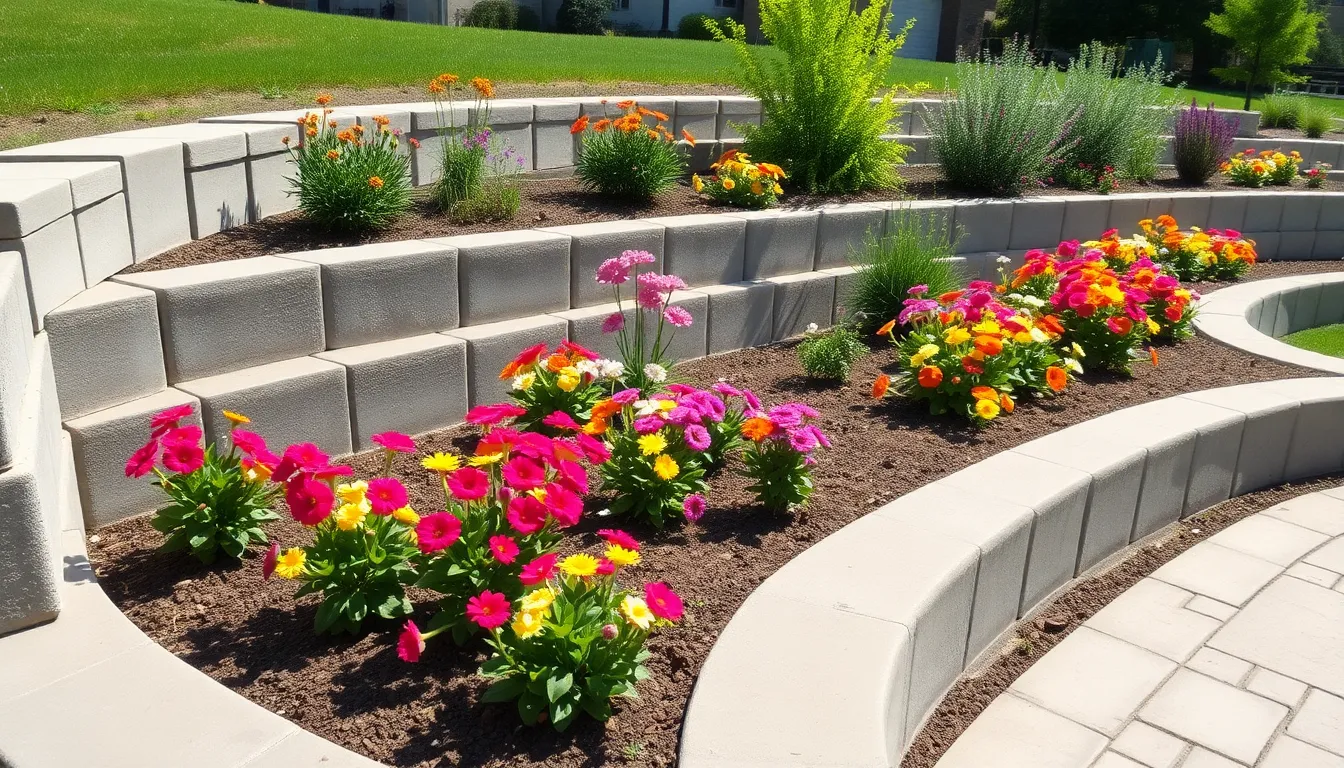
Moving beyond stepping stones, we’ll explore how concrete edging transforms garden boundaries into stunning design elements. These versatile answers offer both functionality and aesthetic appeal for any outdoor space.
Curved Concrete Borders for Flower Beds
Curved concrete edging creates smooth flowing lines that soften traditional garden boundaries and enhance natural beauty. We use wet concrete, wood stakes, and a garden hose to achieve these organic shapes that complement your plantings perfectly.
Installation begins with marking your desired curve using the garden hose as a flexible guide. Position wood stakes every 2-3 feet along the marked line to support the concrete form. Pour the wet concrete mixture into the formed channel, smoothing it with an edging tool to create seamless borders.
Gentle curves work best for flower bed borders because they mirror nature’s organic patterns. The technique provides a permanent solution that eliminates the need for constant maintenance of traditional edging materials like plastic or metal strips.
Concrete Block Raised Garden Beds
Concrete blocks create elevated growing spaces that improve drainage and provide better accessibility for plant care. These modular units stack easily to form raised beds of varying heights and configurations.
Construction requires minimal tools since concrete blocks interlock naturally without mortar in most applications. We recommend standard 8x8x16 inch blocks for most garden bed projects, though decorative options add visual interest.
Elevated beds offer important advantages including improved soil drainage, easier weed control, and reduced bending during garden maintenance. The concrete blocks also retain soil heat longer, extending growing seasons in cooler climates.
Informal seating areas emerge when you design the bed walls at appropriate heights. A 16-18 inch wall height provides comfortable seating while maintaining proper growing depth for most plants.
Poured Concrete Retaining Walls
Poured concrete walls stabilize sloped terrain while creating level planting areas throughout your garden space. These permanent structures handle important soil pressure and provide decades of reliable performance.
Design flexibility allows for various textures and colors that match your existing garden aesthetic. We can incorporate stamps, molds, or pigments during the pouring process to achieve looks that mimic natural stone or brick patterns.
Construction involves proper foundation preparation, reinforcement placement, and careful concrete placement to ensure structural integrity. Professional installation ensures proper drainage systems behind the wall to prevent water buildup.
Functionality extends beyond simple soil retention as these walls create terraced garden levels perfect for showcasing different plant collections. The solid concrete surface also provides mounting points for outdoor lighting or decorative elements.
Decorative Concrete Garden Sculptures and Art
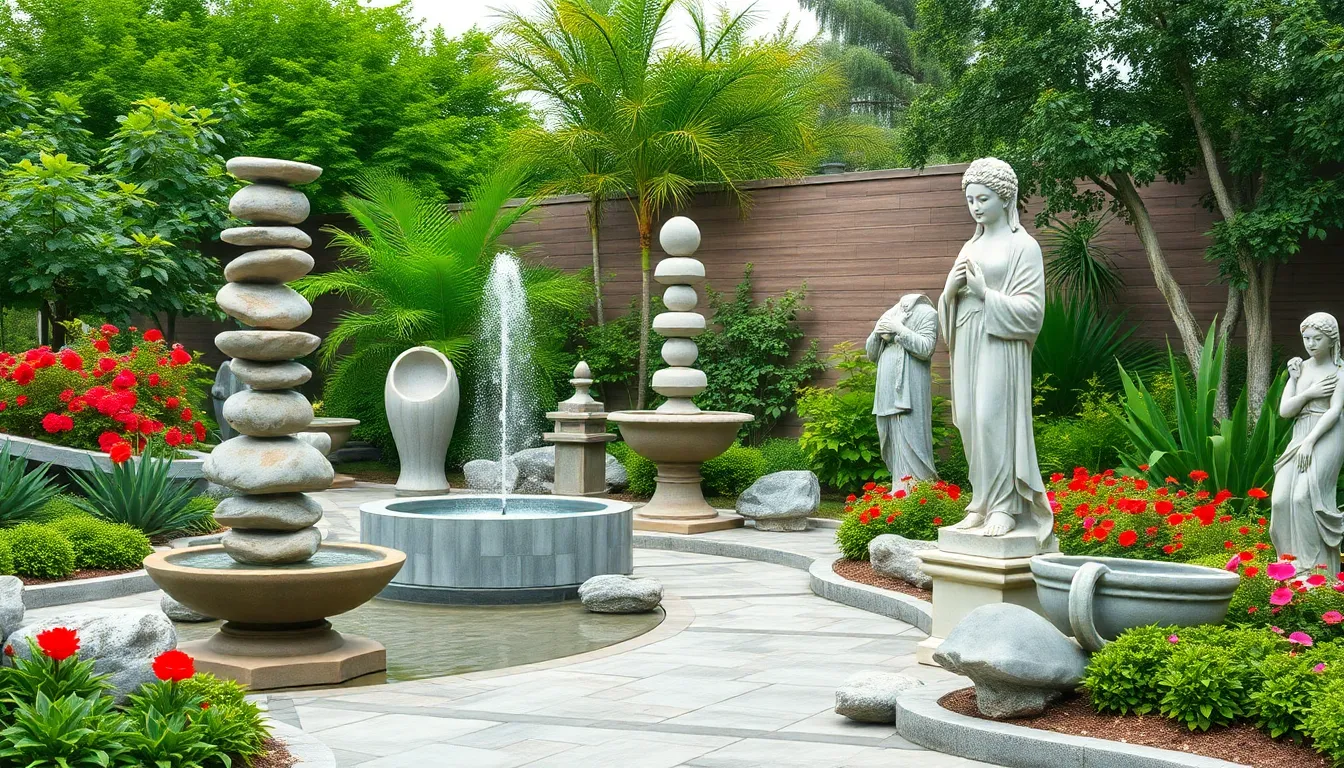
Concrete sculptures transform ordinary garden spaces into captivating outdoor galleries. We’ll explore three distinctive approaches to creating artistic focal points that complement your concrete garden design.
Abstract Concrete Garden Totems
Stacked totems offer unlimited creative possibilities for vertical garden art. We recommend creating these sculptures by stacking concrete blocks or cylinders with different textures and colors to add compelling visual interest throughout your space.
Nature inspired designs bring organic beauty to structured concrete gardens. These totems work exceptionally well when we use natural elements like leaves or branches to create unique molds, adding an authentic organic feel that balances the industrial aesthetic of concrete materials.
Textural variety becomes the key to successful totem design. We suggest alternating smooth and rough surfaces within each stack to create ever-changing shadow play throughout different times of day.
Concrete Water Feature Fountains
Small pond fountains create tranquil gathering spaces within concrete garden settings. We can construct these features using concrete to build intimate ponds with integrated fountains, providing both soothing sounds and stunning visual appeal that enhances the overall garden atmosphere.
Wall mounted fountains maximize space efficiency in compact concrete gardens. These designs allow us to incorporate water elements without sacrificing valuable ground space, making them perfect for urban settings or smaller outdoor areas.
Installation flexibility makes concrete fountains ideal for various garden layouts. We can customize the size, shape, and water flow patterns to complement existing concrete elements like planters and walkways.
Hand-Carved Concrete Garden Statues
Classical figures bring timeless elegance to modern concrete garden designs. We often hand carve statues of Greek gods or mythological creatures to create sophisticated focal points that add cultural depth and artistic refinement to outdoor spaces.
Nature inspired statues blend seamlessly into garden environments. These sculptures work beautifully when we create designs inspired by trees, flowers, or other natural forms that complement planted areas while maintaining the concrete theme.
Artistic longevity makes hand carved concrete statues excellent long term investments. We appreciate how these custom pieces develop character over time as weather naturally ages the surface, creating unique patina effects that enhance their visual appeal.
Functional Concrete Garden Furniture Ideas
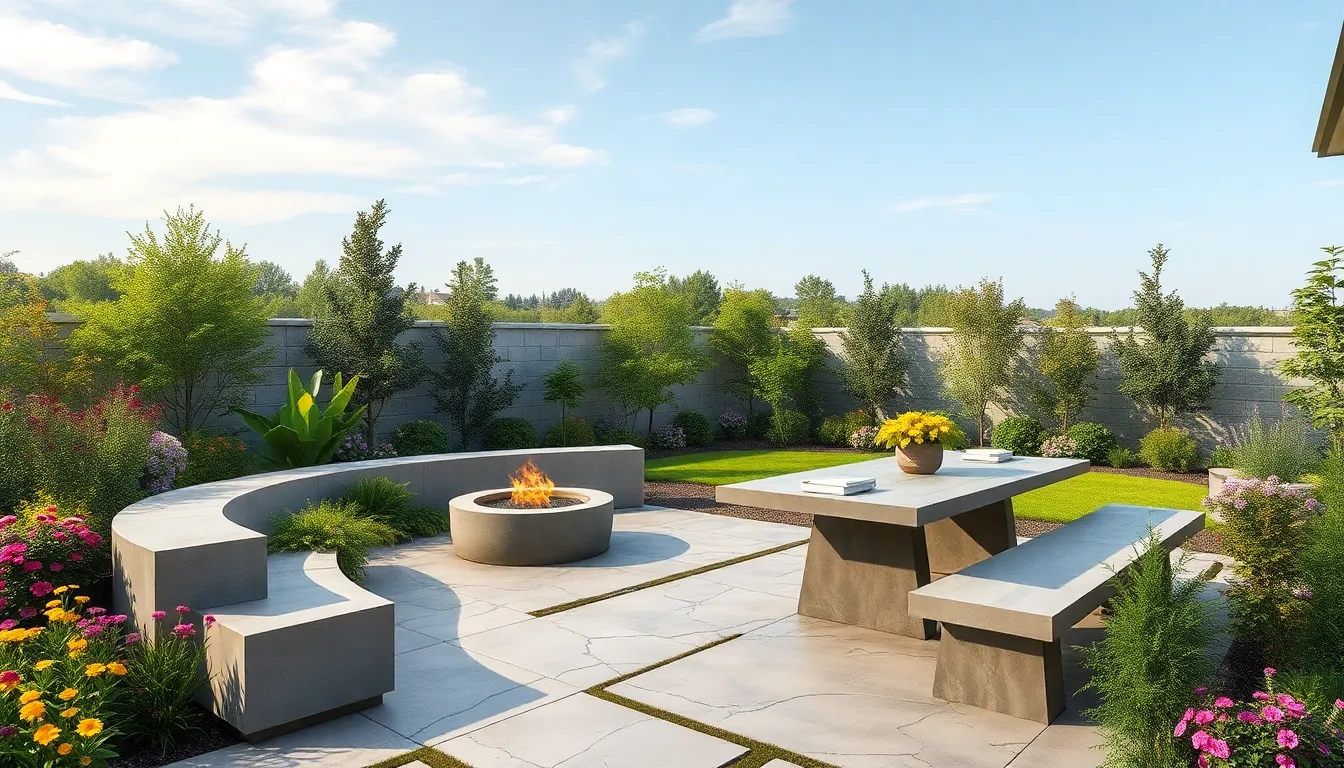
Moving beyond decorative elements, we’ll explore how concrete transforms into practical seating and dining answers that anchor your outdoor living spaces. These durable furniture pieces combine form with function to create lasting focal points in any garden design.
Built-In Concrete Garden Benches
Integrating concrete benches directly into garden walls creates seamless outdoor seating that flows naturally with your industry design. These permanent installations eliminate the need for movable furniture while establishing defined gathering areas throughout your garden space. Built-in designs often incorporate integrated planters that maintain lush greenery around seating areas, creating intimate garden nooks perfect for quiet contemplation.
Combining materials like wood and concrete produces rustic yet modern bench designs that complement various architectural styles. The concrete provides structural durability while wood accents add warmth and comfort to the seating surface. Weather-resistant properties ensure these benches withstand seasonal changes without requiring regular maintenance or replacement.
Creating terraced seating areas using built-in concrete benches maximizes sloped garden terrain while providing multiple levels of outdoor gathering spaces. These installations work particularly well in larger gardens where you want to establish distinct zones for different activities. Integrated lighting can be incorporated during construction to extend usability into evening hours.
Concrete Fire Pit Seating Areas
Building fire pit areas surrounded by concrete seating transforms outdoor spaces into cozy year-round gathering spots. The concrete provides a sturdy, heat-resistant surface that safely accommodates fire features while creating comfortable seating for multiple guests. These installations work especially well for chilly evenings when you want to extend outdoor entertaining seasons.
Circular concrete seating arrangements around central fire pits encourage conversation and create intimate social atmospheres. The thermal mass of concrete helps radiate warmth even after fires die down, extending comfort throughout cooler months. Customizable designs allow for built-in storage compartments for firewood or outdoor accessories.
Combining fire pit seating with integrated planters creates living walls that provide privacy and natural beauty around gathering areas. These designs soften the hard edges of concrete while maintaining the functional benefits of durable outdoor furniture. Strategic plant placement also helps contain smoke and sparks naturally.
Concrete Outdoor Dining Tables
Customizable concrete dining tables offer weather-resistant surfaces that can be designed with embedded metal patterns or decorative tile inlays. These permanent installations eliminate concerns about storing outdoor furniture during harsh weather while providing stable surfaces for outdoor meals. Design flexibility allows for integration with existing patio materials and color schemes.
Creating oversized concrete dining surfaces accommodates large gatherings while maintaining the durability needed for frequent outdoor use. Unlike traditional outdoor furniture that may wobble or deteriorate, concrete tables provide solid foundations for everything from casual barbecues to formal outdoor dinner parties. Integrated benches can be incorporated to complete the dining set.
Adding concrete dining islands with built-in storage compartments transforms outdoor kitchens into fully functional cooking and entertaining spaces. These installations often include areas for grills, prep surfaces, and dining areas all within one cohesive concrete design. Strategic placement near outdoor cooking areas creates efficient workflows for outdoor meal preparation and serving.
Concrete Raised Bed Systems for Vegetable Gardens
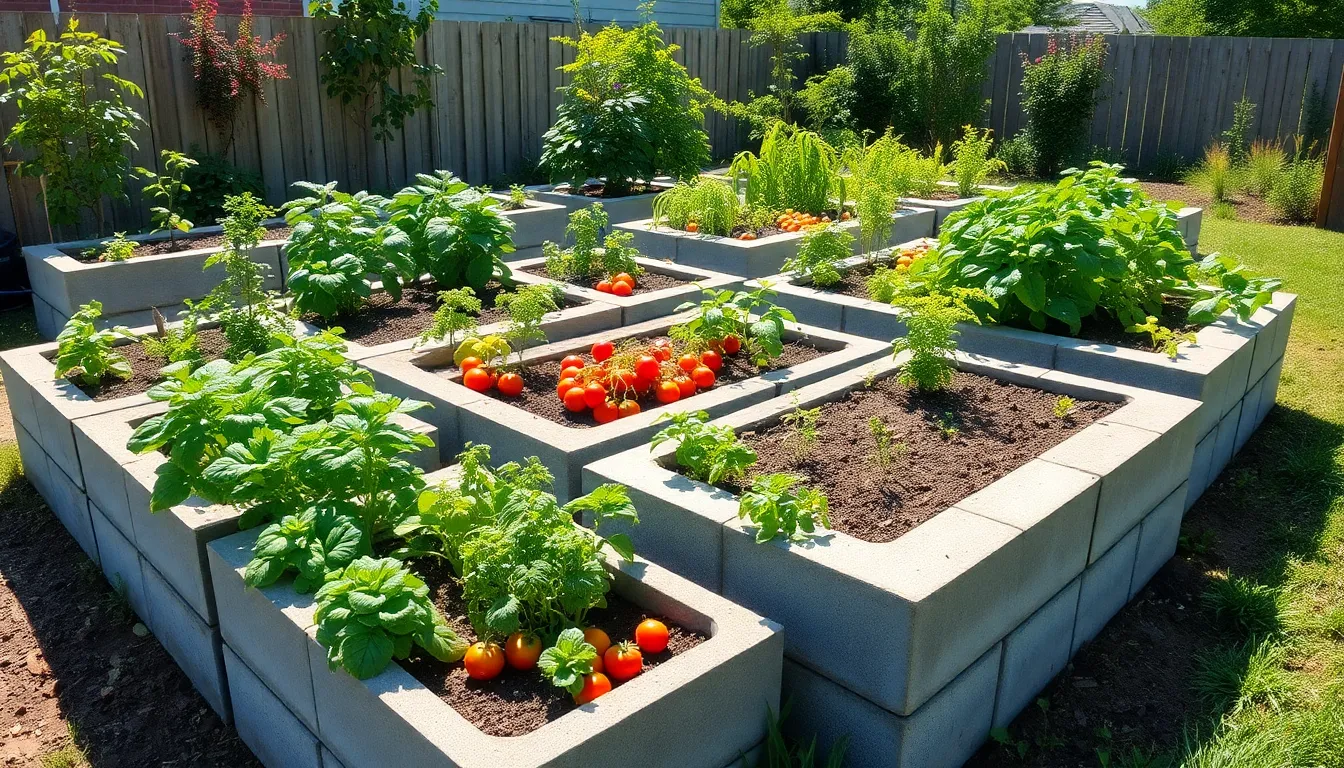
Moving from decorative elements to practical growing answers, concrete raised bed systems offer gardeners superior control over soil quality and drainage while creating organized vegetable growing spaces. These durable structures eliminate soil compaction issues and provide excellent accessibility for planting, weeding, and harvesting throughout the growing season.
Modular Concrete Block Raised Beds
Modular concrete block systems transform cinder blocks and concrete pavers into highly customizable vegetable gardens that adapt to any space configuration. We can arrange these blocks in rectangular, L-shaped, or curved formations to accommodate different garden layouts and plant requirements.
Assembly becomes straightforward since these blocks stack without mortar, allowing us to adjust height based on root depth needs for various vegetables. Tomatoes and peppers thrive in 12-inch deep beds, while root vegetables like carrots require 18-inch depths for optimal growth.
Cost effectiveness makes modular systems ideal for budget-conscious gardeners, with basic cinder blocks costing approximately $2-3 per block compared to $15-20 for specialty garden blocks. We can create a 4×8 foot raised bed using standard blocks for under $100 in materials.
Container gardening integration allows us to place smaller pots within the block framework, creating microclimates for herbs like basil and oregano that require different soil conditions than surrounding vegetables.
Poured Concrete Permanent Garden Boxes
Poured concrete structures create extremely durable garden boxes that withstand decades of weather exposure while maintaining their structural integrity. These permanent installations require more initial planning but deliver superior longevity compared to wood or plastic alternatives.
Custom shaping capabilities allow us to design garden boxes that fit exact industry contours, including curved edges that complement existing hardscaping or architectural features. We can incorporate built-in irrigation channels and drainage systems during the pouring process.
Solid boundary establishment prevents soil erosion and root wandering, keeping aggressive plants like mint contained while protecting neighboring vegetable varieties. The concrete walls also retain soil moisture more effectively than porous materials.
Labor considerations require professional installation or advanced DIY skills, including proper foundation preparation, reinforcement placement, and concrete mixing techniques. Planning phases typically involve soil testing, drainage assessment, and permit verification for permanent structures.
Concrete-Lined In-Ground Garden Beds
Concrete lining systems improve existing in-ground gardens by creating stable soil retention walls that prevent erosion during heavy rainfall or irrigation cycles. These installations work particularly well in sloped areas where traditional beds struggle with water runoff.
Drainage improvement occurs when we install perforated concrete liners that allow excess water to escape while maintaining soil structure and preventing compaction. This creates optimal growing conditions for vegetables that require consistent but not waterlogged soil.
Moisture retention benefits emerge from concrete’s thermal mass properties, which moderate soil temperature fluctuations and reduce watering frequency during hot summer months. Root vegetables like beets and turnips particularly benefit from this stable growing environment.
Professional installation requirements often make concrete-lined beds more expensive initially, with costs ranging from $15-25 per linear foot depending on depth and reinforcement needs. But, the long-term durability and reduced maintenance make these systems cost-effective over time.
Industrial Style Concrete Container Gardens
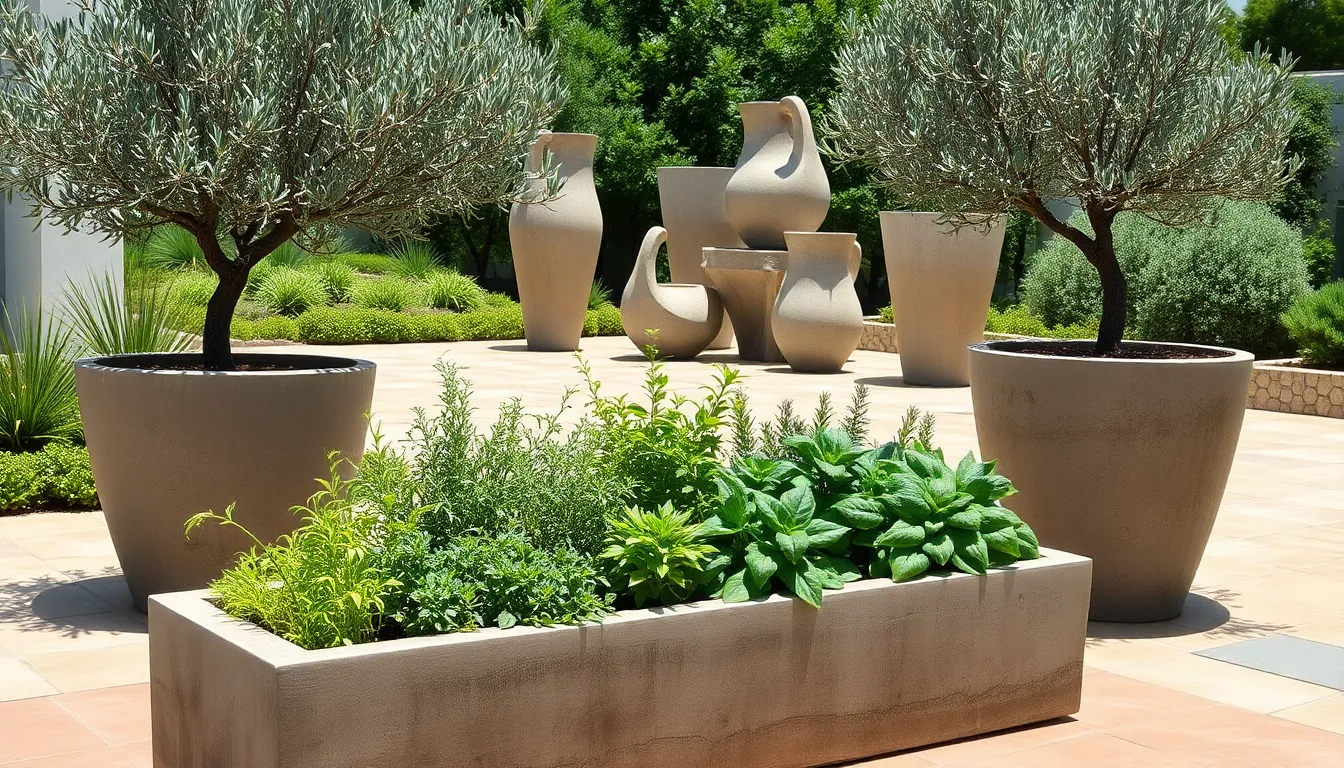
Industrial style concrete container gardens bring urban sophistication to our outdoor spaces through raw materials and bold architectural forms.
Large-Scale Concrete Planters for Trees
Large concrete planters accommodate full-sized trees and mature shrubs while providing the structural integrity needed for substantial root systems. We’ve found these planters work exceptionally well for specimen trees like olive trees, Japanese maples, and dwarf fruit trees that require stable growing conditions. Heavy-duty concrete construction prevents cracking under root pressure and weather stress, making these planters ideal for long-term tree cultivation.
Creating custom large planters allows us to match exact architectural styles through varied textures and finishes. Raw concrete surfaces complement modern industrial aesthetics, while polished finishes suit contemporary settings. We can incorporate drainage systems directly into the concrete pour, ensuring proper water management for tree health.
Budget-conscious gardeners can build these planters using DIY concrete forms and rebar reinforcement. Standard dimensions range from 36 inches wide for smaller ornamental trees to 60 inches for mature specimens, with depths of 24 to 36 inches to accommodate root development.
Concrete Trough Planters for Herbs
Concrete trough planters maximize our herb growing potential in compact spaces through their elongated design. These rectangular vessels typically measure 36 to 48 inches in length and 8 to 12 inches in width, allowing us to plant multiple herb varieties in organized rows.
Modern sleek trough designs feature smooth surfaces and clean lines that complement contemporary outdoor kitchens and dining areas. We can position these planters along deck railings, patio edges, or walkways for easy access during cooking and harvesting.
Rustic industrial versions incorporate exposed aggregate finishes or metal accents that echo warehouse and loft aesthetics. These planters work particularly well for Mediterranean herbs like rosemary, thyme, and oregano that thrive in well-draining concrete containers.
Drainage becomes critical in trough planters due to their shallow depth. We recommend drilling holes every 12 inches along the bottom and adding a gravel layer to prevent waterlogged soil conditions.
Brutalist Inspired Concrete Garden Vessels
Brutalist inspired concrete vessels celebrate raw concrete’s unfinished beauty through bold geometric forms and exposed textures. These architectural planters feature angular shapes, massive proportions, and deliberately rough surfaces that showcase concrete’s natural character.
We see these vessels as sculptural elements that anchor garden compositions while housing dramatic plantings. Their monolithic appearance creates striking contrasts with soft foliage textures and flowing plant forms. Popular shapes include massive rectangular blocks, cylindrical towers, and angular pyramid forms.
Unpolished concrete surfaces develop unique patina effects over time as weather exposure creates natural color variations and texture changes. This aging process enhances the brutalist aesthetic and adds character that manufactured planters can’t replicate.
Strategic placement of brutalist vessels transforms ordinary garden spaces into gallery-like outdoor rooms. We recommend grouping vessels of varying heights to create ever-changing visual compositions that draw attention and establish focal points throughout the industry.
Conclusion
We’ve explored the remarkable versatility of concrete in garden design and it’s clear that this material offers endless possibilities for creating stunning outdoor spaces. From sleek modern planters to artistic sculptures concrete transforms ordinary gardens into sophisticated retreats that blend functionality with visual appeal.
Whether you’re working with a small urban balcony or a sprawling backyard concrete elements provide the perfect foundation for your gardening vision. The durability and customization options we’ve discussed ensure your concrete garden features will remain beautiful and functional for years to come.
Ready to start your concrete garden project? Begin with one simple element like a DIY stepping stone or concrete planter and watch as your outdoor space transforms into the modern garden oasis you’ve always envisioned.
Frequently Asked Questions
What are concrete gardens and why are they becoming popular?
Concrete gardens combine durability with modern style, appealing to homeowners seeking low-maintenance outdoor spaces. They’ve evolved from basic gray slabs to creative designs featuring stamped patterns, vibrant colors, and textures resembling natural materials. Concrete offers versatility for both small urban spaces and large outdoor areas.
What types of concrete planters work best for urban gardens?
Modern minimalist concrete planters are ideal for urban spaces. Geometric rectangular boxes create clean lines perfect for herbs and succulents, while square variations serve as focal points for larger plants. Cylindrical vessels soften urban environments, and tiered planters maximize vertical space in compact settings.
Can I create concrete garden features myself?
Yes, many concrete garden projects are DIY-friendly. You can create stepping stones with hand-pressed leaf patterns, mosaic tile embedded pathways, and stamped concrete walkways. These cost-effective alternatives to professional installations allow for customization while providing durable, visually appealing results.
How can concrete be used for garden edging and borders?
Concrete offers versatile edging solutions including curved borders for flower beds that create smooth lines with minimal maintenance. Concrete block raised beds improve drainage and accessibility, while poured retaining walls stabilize slopes and create level planting areas for terraced gardens.
What decorative concrete art can I add to my garden?
Consider abstract concrete totems made from stacked blocks, nature-inspired sculptures using organic molds, or hand-carved statues that develop unique patina over time. Concrete water features like small pond fountains and wall-mounted designs add tranquility while maximizing space efficiency.
How can concrete be used for garden furniture?
Concrete creates durable outdoor furniture including built-in benches that integrate with garden walls, terraced seating areas around fire pits, and customizable dining tables. These weather-resistant pieces anchor outdoor living spaces while providing practical solutions for entertaining and relaxation.
Is concrete suitable for vegetable gardening?
Absolutely. Concrete raised bed systems provide superior soil quality control and drainage. Options include modular concrete block beds that are customizable and cost-effective, poured permanent garden boxes for longevity, and concrete-lined in-ground beds that improve soil retention on slopes.
What are industrial-style concrete containers?
Industrial-style concrete containers bring urban sophistication through raw materials and bold architectural forms. These include large-scale planters for trees with structural integrity, concrete trough planters for herbs in compact spaces, and brutalist-inspired vessels that serve as sculptural garden elements.

